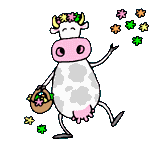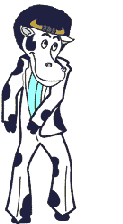I found the entire article on the internet, and I am posting it here for educational purposes.
Cows' creature comforts part of Hawaii's dairy comeback
By Robbie Dingeman
A calif and its mom enjoy life on the Big Isle, where Island Dairy is working to keep the state’s dairy industry alive.
Advertiser library photo

ISLAND DAIRY
How long in business? 1989 (bought an existing dairy in Ahualoa)
Number of employees: 15 people at the 'O'ōkala dairy on the Big Island's Hāmākua Coast
Describe your business: "We basically milk cows twice a day 365 days a year."
Core strategy: "You need to dissect every piece of your business and see how you match up compared to your competitors."
Business tip: "Never give up ... the will to stay despite all the challenges and see that you are doing everything you can. We're looking at every practice that we do continually."
Big change: Expect to complete a 320-stall barn at the end of April with waterbeds, and an increasingly Hawai'i-based diet in a continuing quest to improve cow conditions and milk production.
Fun fact: The next out-of-the-ordinary improvement is a sound system to play calming music in the new barn.
Bahman Sadeghi
Those Big Island cows expecting waterbeds in their stalls will enjoy some other upgrades in accommodations — home-grown corn, piped-in Hawaiian music and an ocean view — all aimed at putting more fresh Island milk on Hawai'i tables.
That's the word from Island Dairy owner Bahman Sadeghi who was at the 'O'ōkala farm yesterday checking on construction progress for the 320-stall barn. Because of increasing demand for locally produced Hawaii's Fresh Milk, the barn is being built with all the "cow comfort" features possible and an increasing emphasis on self-sustainability.
"With the help of the Hawai'i Legislature, KTA, Meadow Gold Dairies, and the support of retailers Foodland, Whole Foods Markets, Don Quijote and Down to Earth, we are making a comeback of the Hawai'i dairy business," Sadeghi said.
He said the dairy also recently added 130 cattle, and it is making a concentrated effort to improve milk production per cow to keep the dairy industry alive in Hawai'i. The number of dairies statewide has dwindled from about 15 in 2007 to only two, both on the Big Island. As recently as 1987 there were 73 dairies statewide.
And although the amenities sound like a punchline on a late-night talk show, they are backed by research, said Dr. Scott Tripp, a Utah-based veterinarian who serves as a consultant to Island Dairy and other farms nationwide.
"The research is very clear that when you have soft soothing music — under 100 beats per minute — they have more milk," Tripp said.
And that holds true with classical music, ballads and quite a bit of Hawaiian music — including The Advertiser's on-hold selection, Tripp said.
"The cows don't care what language it's in because they don't understand English or Hawaiian," Tripp said, but the soothing music boosts milk production 3 percent.
Conversely, Tripp said loud rock music causes milk production to drop 3 percent. "Their least favorite is rock, in between is country-western," he said.
Over the past 10 years, locally produced milk was becoming especially scarce on O'ahu and Kaua'i as community dairies closed because of rising costs and competition with cheaper Mainland imports.
Tripp also has helped Sadeghi explore other Hawai'i-raised food sources for the cows. "The No. 1 cause of the demise of the dairy industry in Hawai'i is escalating feed cost," Sadeghi said.
"If we could grow sugar cane, there's no reason why we can't grow corn," he said. "We have made it our focus to become self-sustainable."
And that's a goal that resonates with more people in Hawai'i.
Sadeghi said it also makes economic sense and will help increase production as more consumers prefer fresher milk, especially if the price is comparable to imported.
He said Tripp's advice has helped the dairy become more efficient with production nearly doubling from 2,500 gallons a day a year ago to today's output of 4,750 gallons per day.
"We've known about music since the '60s," Tripp said, adding that vets know quite a lot about cow preferences. "They're very interesting animals."
Both Tripp and Sadeghi are studying other Hawai'i food sources that could include fish waste, old bread and even macadamia nuts for their fat content.
As for the new cow-tunes, those details are still being worked out, Sadeghi said. "We might put in a Bose system, you never know."










